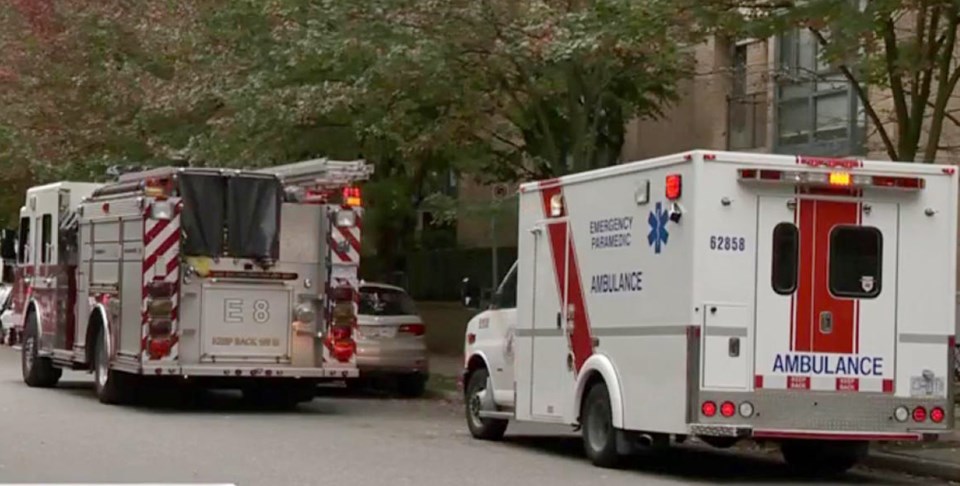An apparent gap in communication has been exposed between the BC Ambulance Service and Richmond Fire-Rescue after a collapsed and bleeding man waited 25 minutes for an ambulance.
While the man in question is OK after the Steveston incident and 25 minutes might not seem too long in a non-life threatening situation, some people – including the Good Samaritan who called 9-1-1 and the local firefighters union - are shaking their heads at the fact an available crew at nearby firehall No. 2 was not tasked to respond, along with the ambulance.
The concerned 9-1-1 caller (who asked not to be named) told the Richmond News how he said “ambulance” when asked by the dispatcher what service he needed and then described to a second person how the man in distress - on Bayview Street on the evening of Saturday, May 13 – had collapsed, had some kind of seizure and was bleeding from his head.
The News understands from E-Comm – which runs the 9-1-1 emergency line – that, once a caller asks for “ambulance,” the call is immediately transferred to the BC Ambulance Service, which is run by BC Emergency Health Services (BCEHS).
It is then up to the BCEHS dispatcher to determine what kind of response is merited, depending on the apparent severity of the situation, as described by the caller.
Also a factor is what kind of “response plan” the municipality in question has submitted to the BCEHS (some cities choose to have their fire departments, who are trained to deal with various emergencies, attend both urgent and routine calls, while others have crews attend only urgent calls).
In terms of the incident in Steveston, a BCEHS spokesperson told the News that, although Richmond Fire-Rescue does “provide assistance to a variety of urgent and non-urgent ambulance calls…this specific incident did not require first responder assistance, based on information provided by the 9-1-1 caller.”
The man who called 9-1-1 was surprised, and concerned, to learn the information he gave didn’t merit a “first responder” type situation.
“Whether the dispatcher didn’t understand the severity of the situation or there was a hiccup in the system, I don’t know?” he said.
“He came out of the fit or seizure he was having, while I was still on the phone. He had blood on his head.
“I’m not a medical professional and I don’t understand the severity of a situation. I just told them what I could see happening.
“I later heard, through a friend, that the firefighters were sitting at their station nearby; they didn’t get the call. I don’t know who’s to blame.”
When told that the BCEHS didn’t give Richmond Fire-Rescue the shout to respond that night, based on the city’s “response plan,” Tim Wilkinson, Richmond’s deputy fire chief, was also surprised, given that he was heavily involved in creating the plan.
“There are about 1,700 different call types; the system is very complex, to be fair to BCEHS,” Wilkinson told the News.
“But, there’s only one category we wouldn’t respond to; “omega” level calls, which is at the lowest end (instances when you might call the BC NurseLine).”
Meanwhile, Corey Parker,president of the local firefighters union (IAFF Local 1286), said this kind of situation – people waiting a long time for an ambulance when firefighters are unaware - is “happening more and more.”
“In this instance, there was a firehall just a few minutes away that could have helped; I’ve checked and they did not have a call at that time.
“I’m obviously upset that this is happening, but especially so in Richmond.
“We’re not advertising that we can do (a paramedic’s job), but there needs to be more attention put on BC Ambulance.”
Parker said he also has a role in the provincial firefighters association, as the vice-president, and “we have spoken about this kind of thing many times.”
“At the end of the day, it’s about the service levels to the citizens of Richmond and I find it absolutely incredible that we had our members sitting there at a firehall, five minutes away, when this man was lying in the street, bleeding.
“We want to help, we’re able and ready to help, but we’re not being allowed to help.”
BCEHS spokesperson Preet Grewal added that, based on the information received from the 9-1-1 caller, the incident was deemed as a “routine response (non-life-threatening).
“We do need to prioritize life-threatening calls — being on scene in less than nine minutes can save a life when someone is choking or having a heart attack, for example.
“Depending on available resources and where ambulances are positioned on the roads, and how the call is coded, that sometimes leaves non-life threatening patients waiting longer. But we do know any length of waiting time can be stressful.”
The spokesperson added that BCEHS dispatchers and call-takers use the Medical Priority Dispatch System (MPDS) and the questions and instructions provided by MPDS are “structured to be highly sensitive in order to not miss serious patient conditions…”
The spokesperson did, however, acknowledge that “clearly, we need to work with (Richmond Fire-Rescue) to figure out what happened.
“Based on the response plan we have for Richmond, it was decided (a first responder wasn’t required).”



